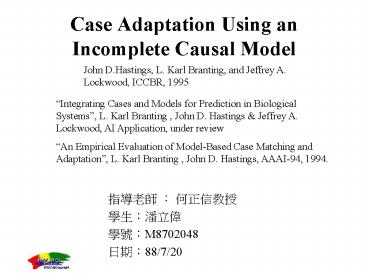Case Adaptation Using an Incomplete Causal Model PowerPoint PPT Presentation
1 / 14
Title: Case Adaptation Using an Incomplete Causal Model
1
Case Adaptation Using an Incomplete Causal Model
John D.Hastings, L. Karl Branting, and Jeffrey A.
Lockwood, ICCBR, 1995
Integrating Cases and Models for Prediction in
Biological Systems, L. Karl Branting , John D.
Hastings Jeffrey A. Lockwood, AI Application,
under review An Empirical Evaluation of
Model-Based Case Matching and Adaptation, L.
Karl Branting , John D. Hastings, AAAI-94, 1994.
- ???? ?????
- ?????
- ??M8702048
- ??88/7/20
2
What Why in CARMA
- CARMA (CAse-based Range Management Adviser)
integrate CBR with MBR to predict the behavior of
biological systems characterized both by
incomplete models and insufficient empirical data
for accurate induction - determining the most cost-effective response to a
given pest infestation requires prediction crop
or forage loss under each available option
3
Cont.
- use of model-based adaptation as a technique for
integrating CBR with MBR in domains in which
neither technique is individually sufficient for
accurate prediction. - Under this approach, Case-based reasoning is used
to find an approximate solution into a more
precise solution
4
Process description
- Using RBR to infer the relevant facts of the
infestation case. - Determine whether grasshopper consumption will
lead to competition with livestock for available
forage - Estimate the proportion of available forage that
will be consumed by grasshoppers using CBR MBR - Total the forage loss estimates for each subcase
to predict the overall proportion of available
forage that will be consumed by grasshoppers
5
Cont.
- Compare grasshopper consumption with the
proportion of available forager needed by
livestock - If competition, determine what possible treatment
options should be excluded using rules - If there are possible treatment options, for each
one provided an economic analysis by estimating
both the first-year and long-term savings using
rule-based, model-based, and probabilistic
reasoning
6
Prototypical cases
- are not expressed in terms of observable
features, but rather in terms of abstract derived
features - are extended in time, representing the history of
a particular grasshopper population over its
lifespan
7
CARMA Step
- Determining relevant case features
- case matching
- model-based adaptation
- (x)case factoring
- temporal projection
- feature adaptation
- critical-period adjustment
- forage loss estimation
- determining treatment options
- treatment recommendation
8
Model-based reasoning
- Case factoring
- spilt the overall population into subcases of
grasshopper with distinct overwintering types - Temporal projection
- retrieval all prototypical cases whose
overwintering types match that of the subcase. - CARMA must project the best matching prototypical
case forward or backwards in time to align its
average developmental phase with that of the new
subcase - CARMA breaks the distribution into daily
populations, projects the populations the
required number of days
9
Featural adaptation
- Modify to account for any featural differences
between it and the subcase. - FL(NC) FL(PC) ? Ai QFD(i)
- QFD (Q(NC, i) - Q(PC, i)) / Q(PC, i)
- A adaptation weights, QFD quantitative
difference for feature I between the new case and
prototypical case
10
Critical Period Adaptation
- Grasshopper consumption is most damaging if it
occurs during the critical forage growing period - must be adapted if the proportion of the lifespan
of the grasshoppers overlapping the the critical
period in the new case differs form that in the
prototypical case
Ex subcaseA 47 case8 6 (47-6)/6
6.83 6.83 adapt weight
11
Learning match and adaptation Weight
- Match weights (by system)
- determining the mutual information gain between
case feature and qualitative consumption
categories in a given set of training cases - Featural adaptation
- use hill-climbing algorithm
- to min RMSE for prototypical case library P and
match weights M, PFL CARMAs predocted forage
loss, ExpertPred experts prediction of
consumption for each training cases Ci
12
Algorithm
- Function AdaptWeights(t, p, M)
- I lt initial increment
- Dmin lt minimum improvement threshold
- Imin lt minimum increment threshold
- A lt initial list of global adaptation weights
- D lt RMSE(T, P, M, A)
- D lt ?
- loop until (I lt Imin) do
- loop until (D-D lt Dmin) do
- D lt D
- ? lt the change to an element of A by I for
which RMSE(T, P, M, ?(A)) is least - D lt RMSE(T, P, M, ?(A))
- if (D lt D) then A lt ?(A) else D lt D
- I lt I/2
- return A
13
Test function
- Fuction LeaveOneOutSpecificTest(T)
- for each case Ci?T do
- P T - Ci prototypical cases
- M global match weights for set P according to
info. Gain - for each prototypical case Pj?P do
- T P - Pj training set
- Pj(A) Adaptweights(T, Pj, M)
- Di (PredictForageLoss(Ci, P, M) -
ExpertPred(Ci))2 - return((Avg(D)(1/2))
- Fuction LeaveOneOutGloubleTest(T)
- for each case Ci?T do
- P T - Ci prototypical cases
- M global match weights for set P according to
info. Gain - G Adaptweights(T, Pj, M)
- Di (PredictForageLoss(Ci, P, M, G) -
ExpertPred(Ci))2 - return((Avg(D)(1/2))
14
Schedule

